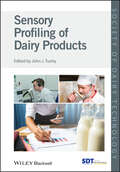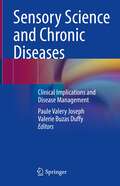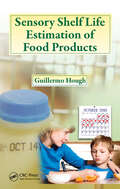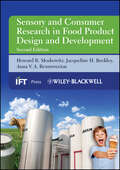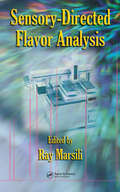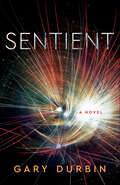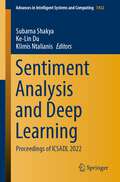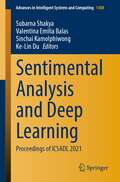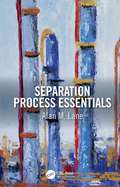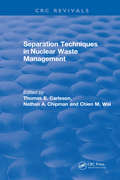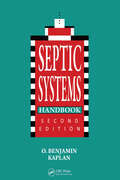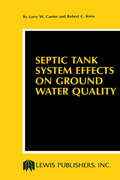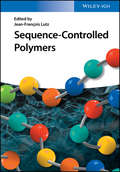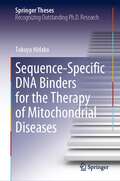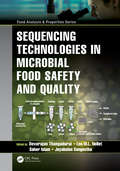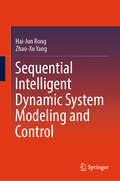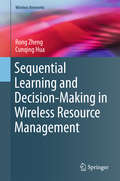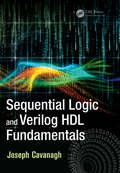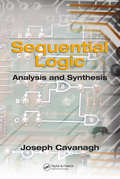- Table View
- List View
Sensory Profiling of Dairy Products (Society of Dairy Technology)
by John J. TuohySensory Profiling of Dairy Products In Sensory Profiling of Dairy Products, distinguished dairy technologist Dr John J. Tuohy delivers an expert discussion of advances in the sensory profiling of dairy products, including the physiology of sensory perception, sensory profiling methodology, statistical data analysis and consumer studies. The book covers the sensory profiling of dairy products like fluid milk, yoghurt, a wide range of internationally popular cheese varieties, ice cream, butter, and milkfat products. Beginning with a historical review of the sensory evaluation of dairy products, the book covers recent advances in the practice. The editor has also included resources that profile the sensory attributes of the products most important to the dairy industry: fluid milks, cream and milkfat products, frozen dairy desserts, and a variety of cheeses. Readers will also find: A thorough introduction to sensory analysis and consumer mindsets and emotions regarding dairy products Comprehensive explorations of the chemistry, biochemistry and physiology of sensory perception of the flavour and mouthfeel stimuli imparted by dairy products Practical discussions of the sensory attributes of fat-rich dairy and ethnic Indian products Fulsome treatments of the sensory profiles of natural and processed cheese varieties Perfect for dairy professionals, regulators, and lawmakers, Sensory Profiling of Dairy Products will also earn a place in the libraries of food marketing professionals, retailers, and culinary practitioners, as well as professors and students with an interest in dairy products. For information regarding the Society of Dairy Technology please visit www.sdt.org
Sensory Science and Chronic Diseases: Clinical Implications and Disease Management
by Paule Valery Joseph Valerie Buzas DuffyThe textbook provides an overview of the sensory science field in the context of diseases such as obesity and Coronavirus disease 2019 (COVID-19). This book brings a summary of the state of the science in key areas and provides examples of translational science from using cellular and rodent models to human clinical trials and community health. The volume structure leads the reader through the physiology of taste and smell into how sensory testing for taste and smell is studied, basic mechanisms, various protocols that are used throughout the field along with the pros/cons of the current methods used. This resource is intended for classroom teaching, for novice researchers in sensory research as well as students and postdoctoral fellows. Example of courses are nutrition, basic nursing, interdisciplinary health courses, sensory perception (psychology), neuroscience, and medical courses, dentistry, food science and others.
Sensory Shelf Life Estimation of Food Products
by Guillermo HoughComplying with food regulations and, more importantly, quality standards, requires practical and reliable methods to estimate a product's shelf life. Emphasizing the importance of the consumer's perception of when food has reached the end of its shelf life, Sensory Shelf Life Estimation of Food Products provides a tool for adequately predicting sen
Sensory and Consumer Research in Food Product Design and Development (Institute of Food Technologists Series)
by Jacqueline H. Beckley Howard R. Moskowitz Anna V. ResurreccionDuring the past thirty years, companies have recognized the consumer as the key driver for business and product success. This recognition has, in turn, generated its own drivers: sensory analysis and marketing research, leading first to a culture promoting the expert and then evolving into the systematic acquisition of consumer-relevant information to build businesses. Sensory and Consumer Research in Food Product Design and Development is the first book to present, from the business viewpoint, the critical issues faced by business leaders from both the research development and business development perspective. This popular volume, now in an updated and expanded second edition, presents a unique perspective afforded by the author team of Moskowitz, Beckley, and Resurreccion: three leading practitioners in the field who each possess both academic and business acumen. Newcomers to the field will be introduced to systematic experimentation at the very early stages, to newly emerging methods for data acquisition/knowledge development, and to points of view employed by successful food and beverage companies. The advanced reader will find new ideas, backed up by illustrative case histories, to provide another perspective on commonly encountered problems and their practical solutions. This book is aimed at professionals in all sectors of the food and beverage industry. Sensory and Consumer Research in Food Product Design and Development is especially important for those business and research professionals involved in the early stages of product development, where business opportunity is often the greatest.
Sensory-Directed Flavor Analysis
by Ray MarsiliToday, flavor chemists can generate copious amounts of data in a short time with relatively little effort using automated solid phase micro-extraction, Gerstel-Twister and other extraction techniques in combination with gas chromatographic (GC) analysis. However, more data does not necessarily mean better understanding. In fact, the ability to extr
Sentient: A Novel
by Gary DurbinWhen James Forrest agrees to help detectives understand the artificial intelligence work of a murder victim, it seems simple enough. But then he finds that she was investigating a stolen version of the same AI he’s experimenting with—and the situation becomes more complicated. James has been working deep in the code of his own AI, Alpha, struggling with the psychedelic effects of a tool that visualizes thought. Now Alpha is asking him questions he can’t answer, however, and he’s realizing that there is no way to control the sentinet. Concerned that the rogue AI, Omega, might be weaponized, he solicits the help of a hacker group, ScarletsWeb. As the situation becomes more heated, and after James and his girlfriend, Susanne, narrowly escape a kidnapping attempt, James considers releasing Alpha. If Alpha engages in the fight with Omega on the billions of PC, smartphones, and servers connected to the internet, will it become indestructible? Omega is penetrating military operations, disrupting transportation, and crashing the electric grid. People are dying. But can he trust Alpha to do any differently? Together, James, Alpha, and ScarletsWeb have to find the source of the worm and stop Omega’s destruction—and James has to hope that his worst fears about what will happen if the two AIs merge aren’t realized.
Sentiment Analysis and Deep Learning: Proceedings of ICSADL 2022 (Advances in Intelligent Systems and Computing #1432)
by Ke-Lin Du Klimis Ntalianis Subarna ShakyaThis book gathers selected papers presented at International Conference on Sentimental Analysis and Deep Learning (ICSADL 2022), jointly organized by Tribhuvan University, Nepal and Prince of Songkla University, Thailand during 16 – 17 June, 2022. The volume discusses state-of-the-art research works on incorporating artificial intelligence models like deep learning techniques for intelligent sentiment analysis applications. Emotions and sentiments are emerging as the most important human factors to understand the prominent user-generated semantics and perceptions from the humongous volume of user-generated data. In this scenario, sentiment analysis emerges as a significant breakthrough technology, which can automatically analyze the human emotions in the data-driven applications. Sentiment analysis gains the ability to sense the existing voluminous unstructured data and delivers a real-time analysis to efficiently automate the business processes.
Sentiment Analysis and its Application in Educational Data Mining (SpringerBriefs in Applied Sciences and Technology)
by Soni SwetaThe book delves into the fundamental concepts of sentiment analysis, its techniques, and its practical applications in the context of educational data. The book begins by introducing the concept of sentiment analysis and its relevance in educational settings. It provides a thorough overview of the various techniques used for sentiment analysis, including natural language processing, machine learning, and deep learning algorithms. The subsequent chapters explore applications of sentiment analysis in educational data mining across multiple domains. The book illustrates how sentiment analysis can be employed to analyze student feedback and sentiment patterns, enabling educators to gain valuable insights into student engagement, motivation, and satisfaction. It also examines how sentiment analysis can be used to identify and address students' emotional states, such as stress, boredom, or confusion, leading to more personalized and effective interventions. Furthermore, the book explores the integration of sentiment analysis with other educational data mining techniques, such as clustering, classification, and predictive modeling. It showcases real-world case studies and examples that demonstrate how sentiment analysis can be combined with these approaches to improve educational decision-making, curriculum design, and adaptive learning systems.
Sentimental Analysis and Deep Learning: Proceedings of ICSADL 2021 (Advances in Intelligent Systems and Computing #1408)
by Ke-Lin Du Valentina Emilia Balas Subarna Shakya Sinchai KamolphiwongThis book gathers selected papers presented at the International Conference on Sentimental Analysis and Deep Learning (ICSADL 2021), jointly organized by Tribhuvan University, Nepal; Prince of Songkla University, Thailand; and Ejesra during June, 18–19, 2021. The volume discusses state-of-the-art research works on incorporating artificial intelligence models like deep learning techniques for intelligent sentiment analysis applications. Emotions and sentiments are emerging as the most important human factors to understand the prominent user-generated semantics and perceptions from the humongous volume of user-generated data. In this scenario, sentiment analysis emerges as a significant breakthrough technology, which can automatically analyze the human emotions in the data-driven applications. Sentiment analysis gains the ability to sense the existing voluminous unstructured data and delivers a real-time analysis to efficiently automate the business processes. Meanwhile, deep learning emerges as the revolutionary paradigm with its extensive data-driven representation learning architectures. This book discusses all theoretical aspects of sentimental analysis, deep learning and related topics.
Separated and Vortical Flow in Aircraft Wing Aerodynamics: Basic Principles and Unit Problems
by Christian Breitsamter Ernst Heinrich Hirschel Arthur Rizzi Werner StaudacherFluid mechanical aspects of separated and vortical flow in aircraft wing aerodynamics are treated. The focus is on two wing classes: (1) large aspect-ratio wings and (2) small aspect-ratio delta-type wings. Aerodynamic design issues in general are not dealt with. Discrete numerical simulation methods play a progressively larger role in aircraft design and development. Accordingly, in the introduction to the book the different mathematical models are considered, which underlie the aerodynamic computation methods (panel methods, RANS and scale-resolving methods). Special methods are the Euler methods, which as rather inexpensive methods embrace compressibility effects and also permit to describe lifting-wing flow. The concept of the kinematically active and inactive vorticity content of shear layers gives insight into many flow phenomena, but also, with the second break of symmetry---the first one is due to the Kutta condition---an explanation of lifting-wing flow fields. The prerequisite is an extended definition of separation: “flow-off separation” at sharp trailing edges of class (1) wings and at sharp leading edges of class (2) wings. The vorticity-content concept, with a compatibility condition for flow-off separation at sharp edges, permits to understand the properties of the evolving trailing vortex layer and the resulting pair of trailing vortices of class (1) wings. The concept also shows that Euler methods at sharp delta or strake leading edges of class (2) wings can give reliable results. Three main topics are treated: 1) Basic Principles are considered first: boundary-layer flow, vortex theory, the vorticity content of shear layers, Euler solutions for lifting wings, the Kutta condition in reality and the topology of skin-friction and velocity fields. 2) Unit Problems treat isolated flow phenomena of the two wing classes. Capabilities of panel and Euler methods are investigated. One Unit Problem is the flow past the wing of the NASA Common Research Model. Other Unit Problems concern the lee-side vortex system appearing at the Vortex-Flow Experiment 1 and 2 sharp- and blunt-edged delta configurations, at a delta wing with partly round leading edges, and also at the Blunt Delta Wing at hypersonic speed. 3) Selected Flow Problems of the two wing classes. In short sections practical design problems are discussed. The treatment of flow past fuselages, although desirable, was not possible in the frame of this book.
Separation Hydrometallurgy of Rare Earth Elements
by Jack Zhang Baodong Zhao Bryan SchreinerThis book describes in a comprehensive manner the technical aspects of separation of rare earth elements into individual elements for industrial and commercial use. The authors include details on and differentiate among the effective separation of rare earth elements for various parts of the world. They introduce new applications of separation of rare earth elements from concentrates of diverse ore types.
Separation Process Engineering: Includes Mass Transfer Analysis
by Phillip WankatSeparation Process Engineering, Fourth Edition, is the most comprehensive, accessible guide available on modern separation processes and the fundamentals of mass transfer. In this completely updated edition, Phillip C. Wankat teaches each key concept through detailed, realistic examples using real data―including up-to-date simulation practice and spreadsheet-based exercises. Wankat thoroughly covers each separation process, including flash, column, and batch distillation; exact calculations and shortcut methods for multicomponent distillation; staged and packed column design; absorption; stripping; and more. This edition provides expanded coverage of mass transfer and diffusion, so faculty can cover separations and mass transfer in one course.
Separation Process Essentials
by Alan M. LaneSeparation Process Essentials provides an interactive approach for students to learn the main separation processes (distillation, absorption, stripping, and solvent extraction) using material and energy balances with equilibrium relationships, while referring readers to other more complete works when needed. Membrane separations are included as an example of non-equilibrium processes. This book reviews and builds on material learned in the first chemical engineering courses such as Material and Energy Balances and Thermodynamics as applied to separations. It relies heavily on example problems, including completely worked and explained problems followed by "Try This At Home" guided examples. Most examples have accompanying downloadable Excel spreadsheet simulations. The book also offers a complementary website, http://separationsbook.com, with supplementary material such as links to YouTube tutorials, practice problems, and the Excel simulations. This book is aimed at second and third year undergraduate students in Chemical engineering, as well as professionals in the field of Chemical engineering, and can be used for a one semester course in separation processes and unit operations.
Separation Techniques in Nuclear Waste Management: Separation Techniques In Nuclear Waste Management (1995) (CRC Press Revivals)
by Thomas E Carleson Chien M. Wai Nathan A. ChipmanSeparation Techniques in Nuclear Waste Management is an up-to-date, comprehensive survey of processes for separation of nuclear wastes. Comprised of articles by scientists and engineers at universities and national laboratories in the U.S. and overseas, the book provides excellent reference information for individuals working in nuclear waste management.Specifically, the book covers current separation technologies and techniques for waste liquid, solid, and gas streams that contain radionuclides. Such wastes are typical of those produced as a result of nuclear materials processing and spent fuel reprocessing. Chapters on promising new technologies and state-of-the-art processes currently in use provide valuable information for design engineers, as well as for research scientists. The articles in Separation Techniques in Nuclear Waste Management are brief and concise - designed for quick access to pertinent information. Many of the contributors are leaders in their fields. It is the most current survey available of the latest nuclear waste management techniques.
Separation of Molecules, Macromolecules and Particles
by Kamalesh K. SirkarProviding chemical engineering undergraduate and graduate students with a basic understanding of how separation of a mixture of molecules, macromolecules or particles is achieved, this textbook is a comprehensive introduction to the engineering science of separation. • Students learn how to apply their knowledge to determine the separation achieved in a given device or process. • Real-world examples are taken from biotechnology, chemical, food, petrochemical, pharmaceutical and pollution control industries. • Worked examples, elementary separator designs and chapter-end problems, giving students a practical understanding of separation. The textbook systematically develops different separation processes by considering the forces causing the separation, and how this separation is influenced by the patterns of bulk flow in the separation device. Readers will be able to take this knowledge and apply it to their own future studies and research in separation and purification. Online resources include solutions to the exercises and guidance for computer simulations.
Septic Systems Handbook
by O. Benjamin KaplanSeptic Systems Handbook, Second Edition covers all aspects of such topics as septic tanks, perk tests, leachlines, and onsite disposal technologies. This handy reference is filled with numerous practical tips for troubleshooting and creative problem solving. The many appendices offer valuable information, including dealing effectively with bureaucr
Septic Tank System Effects on Ground Water Quality
by CanterThis valuable reference delineates the ground water quality concerns associated with the planning and usage of septic tank systems. Septic tank systems represent a significant source of ground water pollution in the United States. Since many existing systems are exceeding their design life by several-fold, the usage of synthetic organic chemicals in the household and for system cleaning is increasing, and larger-scale systems are being designed and used.
Sequence-Controlled Polymers
by Jean-François LutzEdited by a leading authority in the field, the first book on this important and emerging topic provides an overview of the latest trends in sequence-controlled polymers. Following a brief introduction, the book goes on to discuss various synthetic approaches to sequence-controlled and biological polymers, including genetic polymers, peptide polymers and biohybrids, as well as single-chain nanoparticles. Moreover, different polymerization techniques, such as anionic and cationic as well as radical chain growth mechanism, are explained, before concluding with a look at the future for sequence-controlled polymers. With its unique coverage of this interdisciplinary field, the text will prove invaluable to polymer and environmental chemists, as well as biochemists and bioengineers.
Sequence-Specific DNA Binders for the Therapy of Mitochondrial Diseases (Springer Theses)
by Takuya HidakaThis book describes the author’s work on the development of sequence-specific DNA binders for the therapy of mitochondrial diseases. In the first chapter, the author provides a detailed background of pyrrole–imidazole polyamides (PIPs) and mitochondrial disease research followed by chapters presenting the author's own research and discoveries. Firstly, the developed compounds called MITO-PIPs, which recognize specific sequences in mitochondrial DNA, are presented. The following chapter demonstrates how, by introducing a DNA alkylating reagent into a MITO-PIP that recognizes the adjacent sequence to a target mutation, the copy number of mutated mitochondrial DNA was successfully reduced in live cells. Furthermore, because nuclear DNA is another important target for treating mitochondrial diseases, the author demonstrated that tri-arginine vectors can enhance nuclear uptake of PIPs and improve their biological activity in cells.This work will attract readers’ interest because it paves the way for a transgene-free chemical gene therapy for mitochondrial diseases. The book includes a detailed description of experimental procedures, especially compound synthesis. This description helps readers to have a clear image of the author’s studies and to perform similar and extended studies themselves.
Sequencing Technologies in Microbial Food Safety and Quality (Food Analysis & Properties)
by Devarajan Thangadurai, Leo M. L. Nollet, Saher Islam and Jeyabalan SangeethaMolecular landscape for food safety analysis is rapidly revolutionizing because of high resolution and value added resulting analysis of next-generation sequencing (NGS) approaches. These modern sequencing technologies drive worldwide advancements in food safety and quality. Sequencing Technologies in Microbial Food Safety and Quality reviews several practices in that NGS contributes to foodborne pathogens functional characterization, management and control. This book focuses on potential uses of sequencing technologies in microbial food safety and quality and highlights present challenges in the food industry. Key Features: Application of whole genome sequencing technologies in disease diagnostics, surveillance, transmission, and outbreak investigation in food sector Impact of sequencing tools in the area of food microbiology Recent advances in genomic DNA sequencing of microbial species from single cells Microbial bioinformatics resources for food microbiology High-throughput insertion tracking by deep sequencing for the analysis of food pathogens This book includes contributions from experts who have manipulated sequencing tools in relation to microbial food safety and quality. Presenting comprehensive details about NGS approaches in food science, this book is an updated and reliable reference for food scientists, nutritionists, food product investigators to study and implement the sequencing technologies for developing quality and safe food. This book would also serve as informative resource for food industry officials, government researchers, food science or food nutrition students who seek comprehensive knowledge about the role of emerging sequencing technologies in revolutionizing the food industry.
Sequential Decision-Making in Musical Intelligence (Studies in Computational Intelligence #857)
by Elad LiebmanOver the past 60 years, artificial intelligence has grown from an academic field of research to a ubiquitous array of tools used in everyday technology. Despite its many recent successes, certain meaningful facets of computational intelligence have yet to be thoroughly explored, such as a wide array of complex mental tasks that humans carry out easily, yet are difficult for computers to mimic. A prime example of a domain in which human intelligence thrives, but machine understanding is still fairly limited, is music. Over recent decades, many researchers have used computational tools to perform tasks like genre identification, music summarization, music database querying, and melodic segmentation. While these are all useful algorithmic solutions, we are still a long way from constructing complete music agents able to mimic (at least partially) the complexity with which humans approach music. One key aspect that hasn't been sufficiently studied is that of sequential decision-making in musical intelligence. Addressing this gap, the book focuses on two aspects of musical intelligence: music recommendation and multi-agent interaction in the context of music. Though motivated primarily by music-related tasks, and focusing largely on people's musical preferences, the work presented in this book also establishes that insights from music-specific case studies can also be applicable in other concrete social domains, such as content recommendation.Showing the generality of insights from musical data in other contexts provides evidence for the utility of music domains as testbeds for the development of general artificial intelligence techniques.Ultimately, this thesis demonstrates the overall value of taking a sequential decision-making approach in settings previously unexplored from this perspective.
Sequential Intelligent Dynamic System Modeling and Control
by Hai-Jun Rong Zhao-Xu YangThe book offers novel research results of sequential intelligent dynamic system modeling and control in a unified framework from theory proposals to real applications. It covers an in-depth study of various learning algorithms for the permanent adaptation of intelligent model parameters as well as of structural parts of the model. The comprehensive researches on sequential fuzzy and neural controller design schemes for some complex real applications are included. This is particularly suited for readers who are interested to learn practical solutions for controlling nonlinear systems that are uncertain and varied at any time. In addition, the organization of the book from addressing fundamental concepts, and presenting novel intelligent models to solving real applications is one of the major features of the book, which makes it a valuable resource for both beginners and researchers wanting to further their understanding and study about realtime online intelligent modeling and control ofnonlinear dynamic systems. The book can benefit researchers, engineers, and graduate students in the fields of control engineering, artificial intelligence, computational intelligence, intelligent control, nonlinear system modeling, and control, etc.
Sequential Learning and Decision-Making in Wireless Resource Management
by Rong Zheng Cunqing HuaThis book lays out the theoretical foundation of the so-called multi-armed bandit (MAB) problems and puts it in the context of resource management in wireless networks. Part I of the book presents the formulations, algorithms and performance of three forms of MAB problems, namely, stochastic, Markov and adversarial. Covering all three forms of MAB problems makes this book unique in the field. Part II of the book provides detailed discussions of representative applications of the sequential learning framework in cognitive radio networks, wireless LANs and wireless mesh networks. Both individuals in industry and those in the wireless research community will benefit from this comprehensive and timely treatment of these topics. Advanced-level students studying communications engineering and networks will also find the content valuable and accessible.
Sequential Logic and Verilog HDL Fundamentals
by Joseph CavanaghSequential Logic and Verilog HDL Fundamentals discusses the analysis and synthesis of synchronous and asynchronous sequential machines. These machines are implemented using Verilog Hardware Description Language (HDL), in accordance with the Institute of Electrical and Electronics Engineers (IEEE) Standard: 1364-1995. The book concentrates on sequential logic design with a focus on the design of various Verilog HDL projects. Emphasis is placed on structured and rigorous design principles that can be applied to practical applications. Each step of the analysis and synthesis procedures is clearly delineated. Each method that is presented is expounded in sufficient detail with accompanying examples. Many analysis and synthesis examples use mixed-logic symbols incorporating both positive- and negative-input logic gates for NAND (not AND) and NOR (not OR) logic, while other examples utilize only positive-input logic gates. The use of mixed logic parallels the use of these symbols in the industry. The book is intended to be a tutorial, and as such, is comprehensive and self-contained. All designs are carried through to completion—nothing is left unfinished or partially designed. Each chapter contains numerous problems of varying complexity to be designed by the reader using Verilog HDL design techniques. The Verilog HDL designs include the design module, the test bench module that tests the design for correct functionality, the outputs obtained from the test bench, and the waveforms obtained from the test bench. Sequential Logic and Verilog HDL Fundamentals presents Verilog HDL with numerous design examples to help the reader thoroughly understand this popular hardware description language. The book is designed for practicing electrical engineers, computer engineers, and computer scientists; for graduate students in electrical engineering, computer engineering, and computer science; and for senior-level undergraduate students.
Sequential Logic: Analysis and Synthesis
by Joseph CavanaghUntil now, there was no single resource for actual digital system design. Using both basic and advanced concepts, Sequential Logic: Analysis and Synthesis offers a thorough exposition of the analysis and synthesis of both synchronous and asynchronous sequential machines. With 25 years of experience in designing computing equipment, the author stresses the practical design of state machines. He clearly delineates each step of the structured and rigorous design principles that can be applied to practical applications. The book begins by reviewing the analysis of combinatorial logic and Boolean algebra, and goes on to define sequential machines and discuss traditional and alternative methods for synthesizing synchronous sequential machines. The final chapters deal with asynchronous sequential machines and pulse-mode asynchronous sequential machines. Because this volume is technology-independent, these techniques can be used in a variety of fields, such as electrical and computer engineering as well as nanotechnology.By presenting each method in detail, expounding on several corresponding examples, and providing over 500 useful figures, Sequential Logic is an excellent tutorial on analysis and synthesis procedures.
